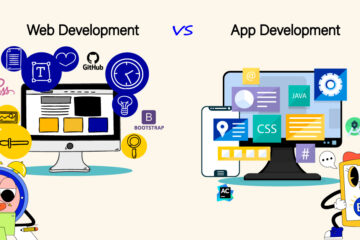
In today’s bustling world, the way we shop has evolved into two distinct paths: online and offline. Online shopping offers convenience, allowing you to browse and purchase from home at any time. It provides access to a wider range of products and competitive prices, often with detailed reviews. However, it lacks the tactile experience of trying before buying and immediate possession of goods, with delivery times varying.
Offline shopping, on the other hand, lets you physically inspect items, try on clothes, and receive instant gratification. It supports local businesses and provides personal interactions, which can enhance the shopping experience. Yet, visiting stores requires time and effort, and the variety might be limited compared to online options.
Ultimately, the choice between online shopping and offline shopping depends on your priorities: convenience and variety versus immediacy and physical experience. Many people find a balance, using both methods to suit different needs. Online shopping vs offline shopping comparison will help you understand the differences between each type of shopping and decide which is better for you.
Table of Contents
What is Online Shopping?
Online shopping is purchasing goods or services via Internet E-commerce platforms. Shoppers visit websites or use mobile apps to explore various products, compare prices, read reviews, and make selections. Items are added to a virtual shopping cart, and the transaction is completed by providing payment and shipping information.
This method offers convenience, a wide range of options, and often competitive prices. Popular platforms for online shopping include Amazon, eBay, and Walmart, catering to diverse consumer needs globally.
What is Offline Shopping?
Offline shopping refers to the traditional method of purchasing goods and services in person. Shoppers physically visit stores such as supermarkets, malls, and local shops to browse items. They can touch, try, and inspect products before making a decision.
After selecting their desired items, customers proceed to the checkout counter to pay, often interacting with sales staff for assistance. This shopping method provides immediate gratification and the opportunity for personal interaction, making it a preferred choice for many consumers.
Online Shopping vs Offline Shopping
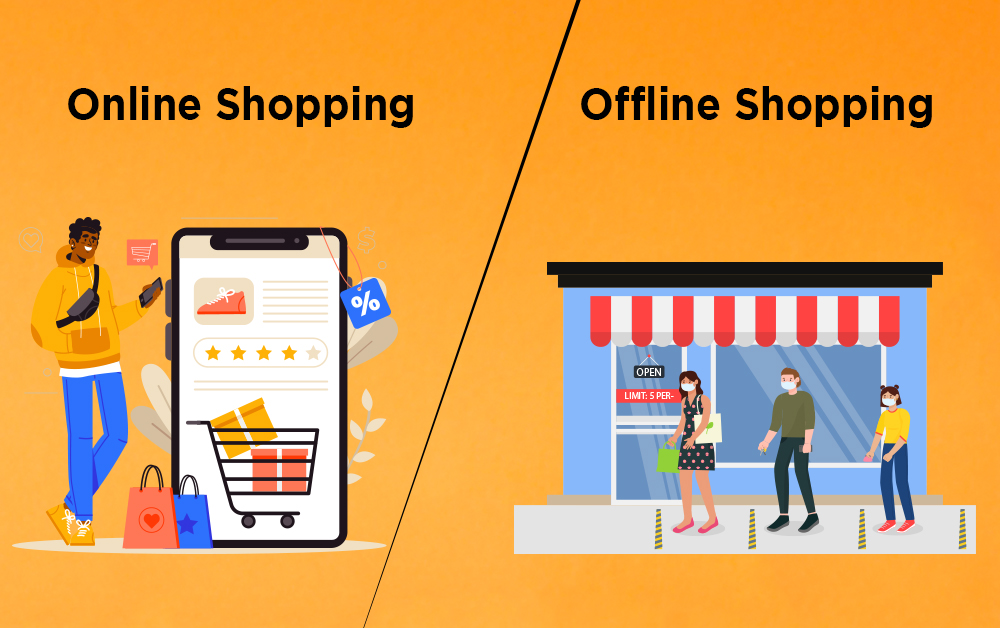
Shopping is a daily necessity, whether for clothes, groceries, or electronics. We can shop online or offline, each with its benefits and drawbacks. Online shopping lets us buy items from the comfort of our homes, offering convenience and a wide selection.
Offline shopping allows us to see and touch items before buying, providing instant access, but it can be time-consuming and limited in variety. Understanding online shopping vs offline shopping comparison helps us choose the best shopping method for our needs. This article will compare online vs offline shopping, highlighting their pros and cons.

The Basics of Online Shopping
Online shopping allows you to buy products or services using the internet. You can browse websites, select items, and pay electronically. The purchased items are delivered to your address or can be picked up at designated locations. It’s convenient, offering a wide range of choices and often better prices.
Major platforms like Amazon and eBay dominate, alongside individual retailer websites. Important considerations include secure payment methods and return policies. Overall, online shopping saves time and lets you shop from virtually anywhere, making it a popular choice for modern consumers.
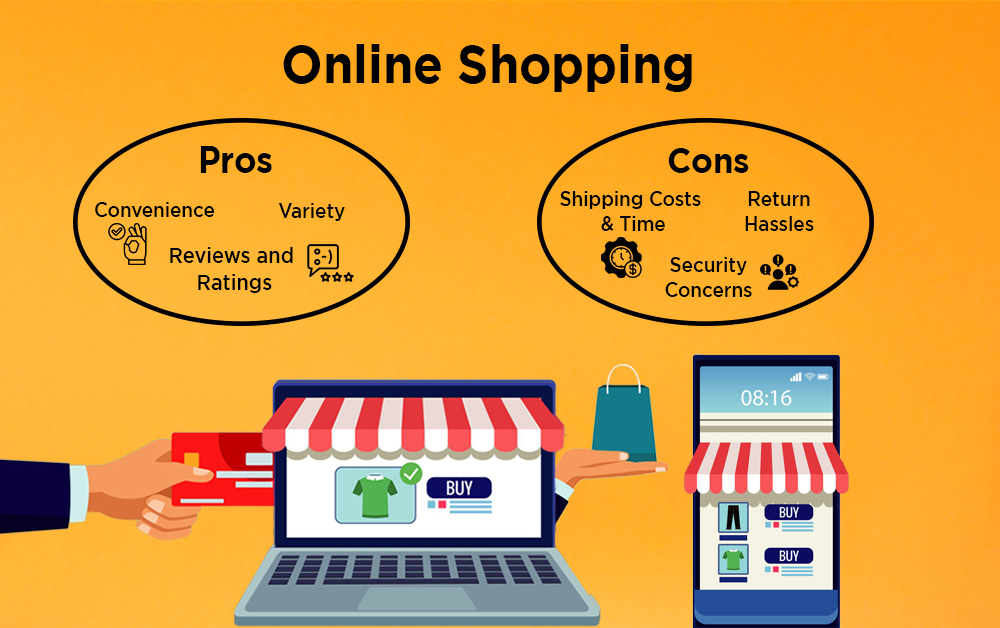
Pros of Online Shopping:
Convenience: Online shopping offers the ease of shopping from home at any time, ideal for busy schedules or limited mobility.
Variety: Online stores offer a wide range of products that may not be available in local stores. You can compare different brands, models, and prices easily.
Price Comparison: Compare prices easily online and find the best deals with discounts and promotions offered by many different websites and stores.
Reviews and Ratings: Online shopping platforms often feature customer reviews and ratings, which can help you make informed purchasing decisions.
Cons of Online Shopping:
Shipping Costs and Time: Shipping can add extra costs to your purchase, and you may have to wait several days or weeks for your items to arrive.
No Physical Inspection: You can’t check products physically before buying online, which might lead to disappointment if they don’t meet your expectations when they arrive.
Return Hassles: Returning items can be more complicated and time-consuming compared to returning them to a physical store.
Security Concerns: There is a risk of fraud and security issues when entering personal and financial information online.
The Basics of Offline Shopping
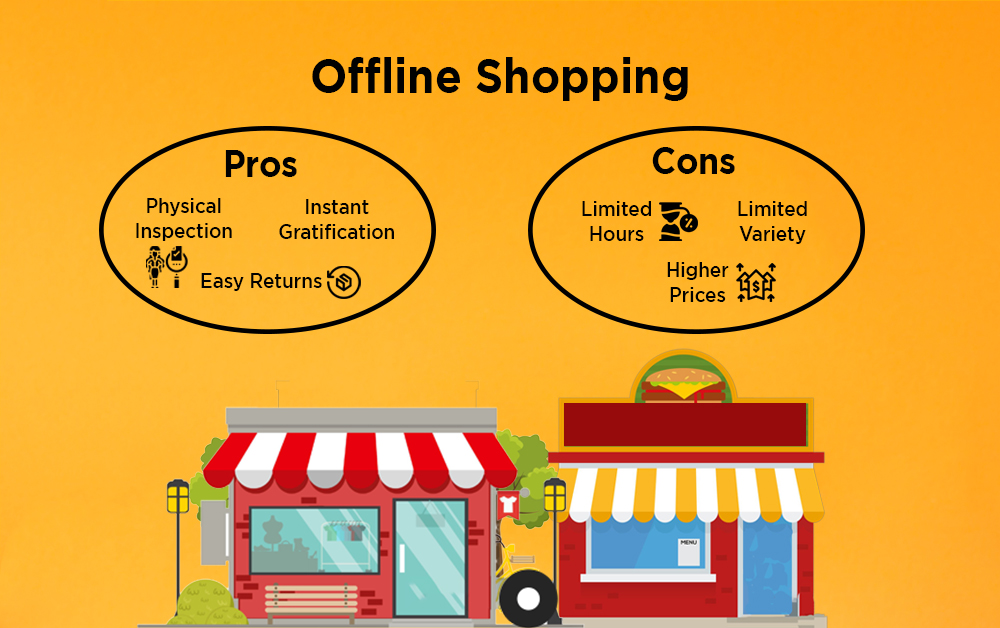
Offline shopping, or traditional shopping, means physically going to stores to buy things. It’s been around for a long time and involves browsing products in person, choosing what you want, and making purchases directly at the store.
It allows for immediate product examination and interaction with salespeople. Despite online shopping’s growth, many people still prefer offline shopping for the hands-on experience and instant gratification of taking items home immediately.
Pros of Offline Shopping:
Physical Inspection: It allows you to see, touch, and try products before purchasing, ensuring you know precisely what you’re getting before making a decision.
Instant Gratification: You can take your purchase home immediately without waiting for shipping.
Personal Interaction: Shopping in physical stores allows for personal interaction with store staff, who can provide assistance and advice.
Easy Returns: Returning items is often easier and quicker since you can go directly to the store.
Cons of Offline Shopping:
Limited Hours: Physical stores have specific operating hours, which may not be convenient for everyone.
Limited Variety: Local stores may not carry the same variety of products as online stores, limiting your choices.
Time and Effort: Offline shopping can be time-consuming and requires effort, such as driving to the store and finding parking.
Higher Prices: Physical stores may have higher prices due to overhead costs like rent and utilities.
Comparing Online Shopping vs Offline Shopping
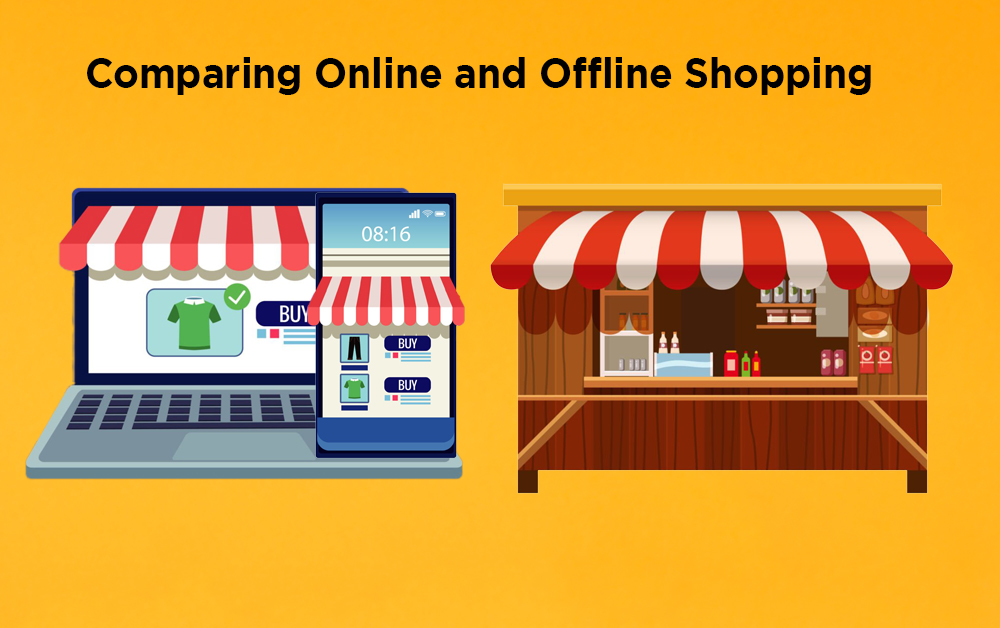
Now that we understand the basics of online and offline shopping, let’s compare them based on several factors to see the difference between online shopping vs offline shopping.
1. Convenience:
Online Shopping: E-commerce lets you purchase from the comfort of your home, anytime, offering unmatched convenience and flexibility.
Offline Shopping: Requires you to visit the store during its operating hours, which may not always be convenient.
2. Product Variety:
Online Shopping: Provides a vast array of products from around the world, often offering more variety than physical stores.
Offline Shopping: Typically offers a limited selection based on the store’s inventory and shelf space.
3. Price Comparison:
Online Shopping: E-shopping makes comparing prices across different websites easy, helping you find the best deals effortlessly.
Offline Shopping: Price comparison requires visiting multiple stores, which can be time-consuming and less efficient.
4. Physical Inspection:
Online Shopping: You cannot physically inspect or try products before purchasing.
Offline Shopping: It lets you see, touch, and try products before making a purchase.
5. Customer Reviews:
Online Shopping: Offers customer reviews and ratings to help you make informed decisions.
Offline Shopping: Lacks extensive customer reviews, though you can seek advice from store staff.
6. Instant Gratification:
Online Shopping: Requires waiting for shipping, which can take days or weeks.
Offline Shopping: It offers immediate satisfaction by allowing customers to take home purchases without delay.
7. Return Policies:
Online Shopping: Returning items can be more complicated and may involve shipping costs and time.
Offline Shopping: Returning items is usually quicker and easier as you can return them directly to the store.
8. Security Concerns:
Online Shopping: Involves entering personal and financial information online, which can be risky if not done on secure websites.
Offline Shopping: Generally safer in terms of personal and financial information, as transactions are done in person.
The Future of Shopping
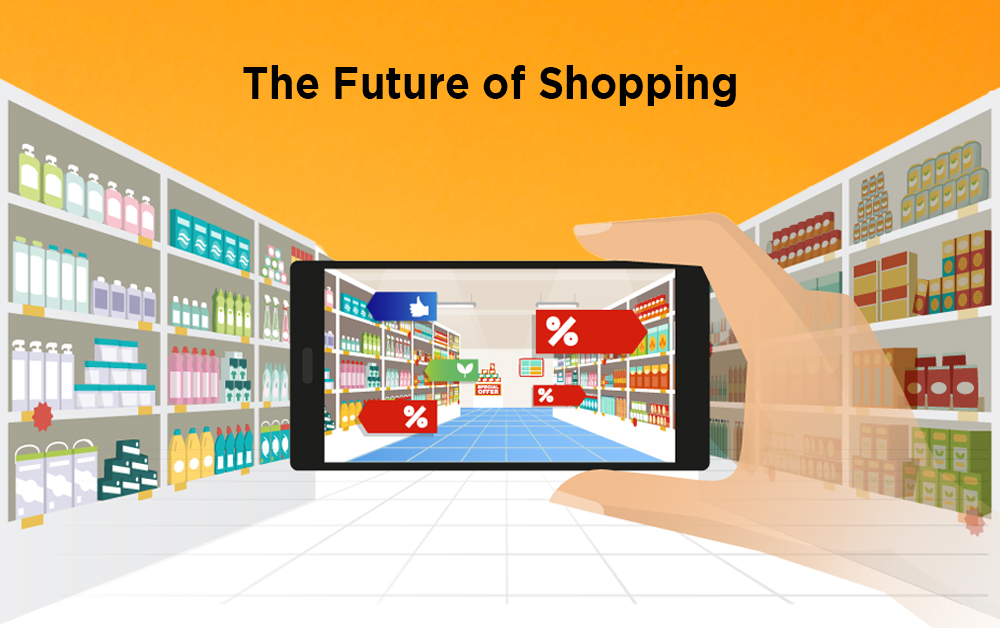
The future of shopping is evolving rapidly as technology integrates the lines between online and offline experiences. Retailers are increasingly offering hybrid services that combine the convenience of online shopping with the immediate satisfaction of offline shopping.
One prominent example is the “click and collect” service, where customers can order products online and pick them up in-store. This approach provides the best of both worlds: the ease of online browsing and purchasing, along with the quick access to products that offline shopping offers.
Advancements in augmented reality (AR) and virtual reality (VR) are revolutionizing the online shopping experience. AR allows customers to try on clothes, makeup, or accessories virtually, helping them see how products will look on them before making a purchase.
Similarly, AR can be used to visualize how furniture and home decor items will fit and look in their homes. VR takes this a step further by creating immersive shopping environments where customers can explore virtual stores and interact with products as if they are physically present.
These technological innovations make online shopping more interactive, giving customers an experience similar to shopping in a physical store. This not only enhances customer satisfaction but also helps shoppers make more informed decisions without needing to visit a store in person.
Therefore, the separation between online shopping vs offline shopping is becoming less defined. By combining the strengths of both online and offline methods, the future of shopping promises to be more flexible, convenient, and personalized than ever before.
In Conclusion
The debate between online shopping vs offline shopping revolves around convenience, variety, and the shopping experience. Online shopping offers unmatched convenience with its ability to shop anytime, anywhere, and access to a vast array of products.
It simplifies price comparison and often provides better deals, but lacks the immediacy of physical inspection and instant gratification. On the other hand, offline shopping allows shoppers to interact with products physically, receive immediate purchases, and benefit from personal assistance. While it may be less convenient and have a narrower selection, it offers a tactile shopping experience that many find satisfying.
Looking ahead, the future of shopping blends these two approaches, using technology to enhance both online and offline experiences. Innovations like AR and VR are bridging the gap, making online shopping more interactive and immersive. Ultimately, choosing between online and offline shopping depends on individual preferences for convenience, interaction, and the immediacy of purchase.

